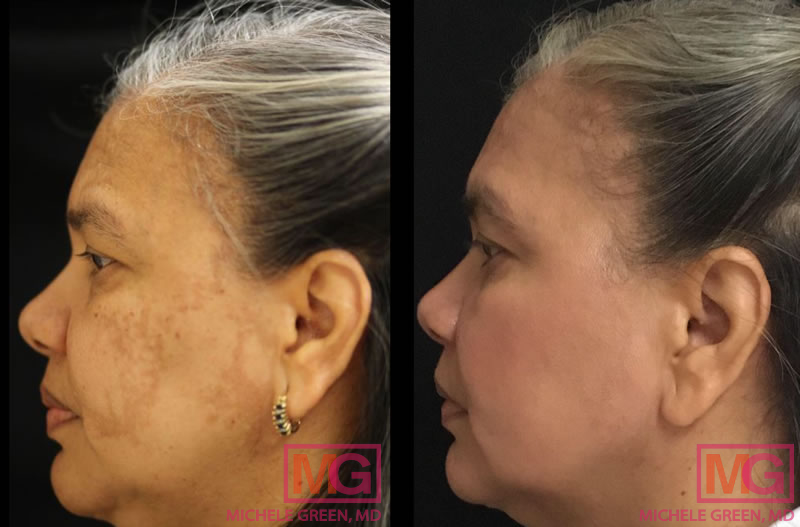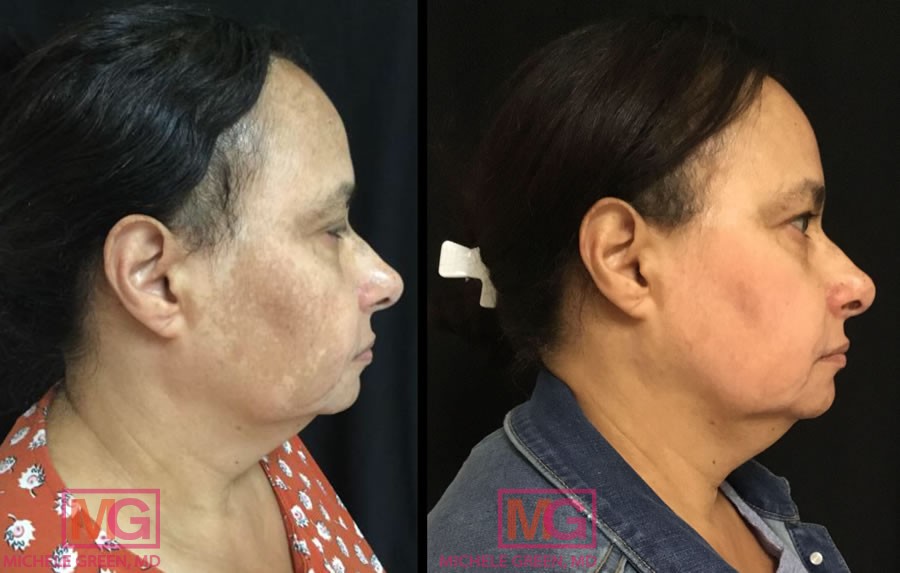What is a Mesopeel Chemical Peel?
A Mesopeel is a specially formulated chemical peel that can be used to address all types of hyperpigmentation on the face and body. A series of Mesopeels can effectively fade unwanted excess pigment and also works to control melanocyte activity. Melanocytes are the skin cells that are responsible for producing melanin, which is the component of the skin that gives it pigment. Mesopeels are designed to treat and fade the appearance of visible skin discoloration, dark spots and photoaging gently yet efficiently. Delicate areas of the body such as the inner thighs, groin, axillae, face, and under eyes may be impacted by hyperpigmentation. These delicate areas cannot be treated with traditional chemical peels, which are far too irritating for use on sensitive skin in these areas.
Mesopeels, through the process of chemo exfoliation, lead to an inflammatory reaction of the reticular dermis and induces new collagen and elastin production. The treatment process also encourages the epidermis to renew at an increased rate, revealing smoother, softer, brighter skin that is more even in tone and texture. Dr. Green will work with you to customize your chemical peel and mesopeel treatment so that it perfectly caters to your needs and results in a healthier overall complexion that lasts.
Dr. Michele Green is an internationally renowned board-certified cosmetic dermatologist in New York City with over two and a half decades of experience providing patients from around the world with the best in non-invasive treatment options, including Botox, dermal fillers, laser resurfacing treatments, chemical peels, and more. Dr. Green is consistently identified as one of NYC’s best dermatologists by Castle Connolly, New York Magazine, Super Doctors, and the New York Times. When you consult with Dr. Green at her private dermatology office in Manhattan’s Upper East Side neighborhood, she takes the time to understand your specific skin concerns. She customizes your treatment plan to cater to your individual needs and helps you achieve your personal cosmetic goals.
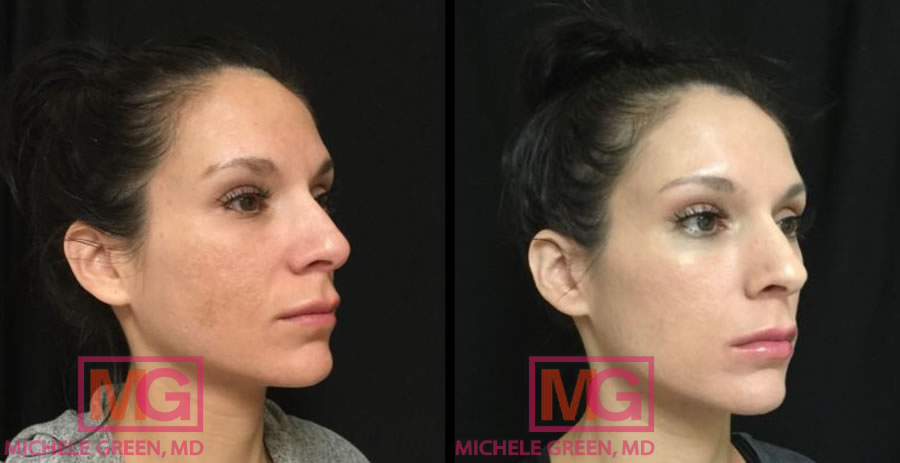
What is a chemical peel?
A chemical peel is a non-invasive cosmetic procedure for anti-aging designed to provoke accelerated skin regeneration. A chemical peel is performed in a controlled manner through the application of various chemo exfoliation agents. The chemical peel breaks the bonds that keep dead skin cells to the skin’s surface, increasing the skin cell turnover rate and revealing healthy, new skin cells that are more even in tone and texture. The key to the best chemical peel treatment is designing a protocol based on your skin type, tone, and skin concerns. Dr. Michele Green is an expert in chemical peels and has been performing the best chemical peels, or acid peels, to treat skin aging, hyperpigmentation, acne, acne scars, dyschromia, photo aging, superficial acne scars, and melasma for over 25 years in her private, boutique dermatology office, located in the Upper East Side neighborhood of Manhattan. Dr. Green understands the nuances of various skin types and creates a customized treatment process for depigmenting the affected areas that leaves the skin clear, rejuvenated, and bright. There are multiple types of chemical peels available in the office of Dr. Green, each of which offers its own unique skin benefits yet provides a rejuvenating effect on the skin.
What does Mesopeel treat?
A Mesopeel treats facial and bodily hyperpigmentation in all of the areas where the skin is too sensitive to be treated with a traditional chemical peel. The Mesopeel can be applied to the axillae, inner thighs, groin, under-eye area, and face. Usually, patients are recommended to have a series of mesopeels at an interval of 3-6 weeks apart to achieve optimal cosmetic results. The exact number of mesopeels required for your treatment may depend on the area of the body being treated and the severity of the initial hyperpigmentation. Different types of Mesopeels can be used to target essentially any form of hyperpigmentation, and Dr. Green will work with you to determine which Mesopeel is right for you.
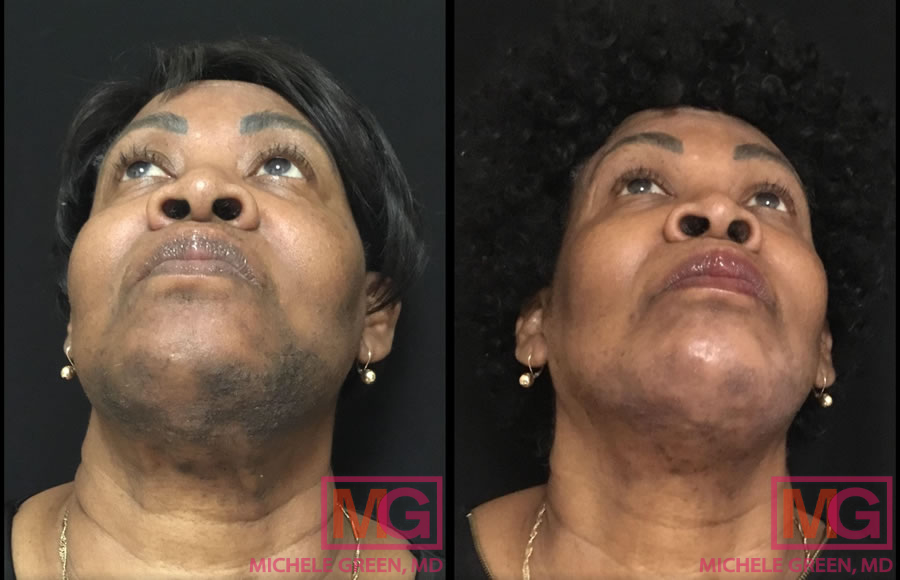
What is Mesoestetic?
Mesoestetic manufactures Mesopeels, Cosmelan peel, and skin care products for at-home use, including depigmenting creams, serums, and SPF. The Mesoestetic company is responsible for several innovative products and treatments that studies have proven to be safe and effective for treating various skin conditions, including hyperpigmentation, acne, wrinkles and fine lines, and more. Pairing the in-office treatment methods with specially formulated skincare products for use at home helps patients achieve optimal, particularly long-lasting cosmetic results. When you work with Dr. Michele Green in NYC, she will take the time to understand your individual skin concerns and customize the recommendations for procedures and products to help you achieve your cosmetic goals and look and feel your absolute best.
What is the difference between Mesopeels and other Chemical Peels?
A Mesopeel is a type of chemical peel that was carefully designed for use on areas of the body where the skin is particularly sensitive and can not be treated with a traditional chemical peel. Mesopeels are just one of the types of chemical peels offered in the Upper East Side private office of board-certified cosmetic dermatologist Dr. Michele Green.
A trichloroacetic acid, or TCA, peel is a type of chemical peel that is offered in varying strengths and depths to treat an array of skin conditions, including acne breakouts, fine lines and wrinkles, hyperpigmentation, dullness, and sun damage. A TCA peel removes the surface layers of the epidermis, encouraging increased skin cell renewal to reveal a healthier, brighter, and smoother complexion. The TCA peel also helps keep pores clear of sebum, dead skin cells, and debris to prevent breakouts and acne. Dr. Green will consult with you before your TCA chemical peel so that your treatment is perfectly catered to your skin needs.
Cosmelan is another variety of chemical peel that was initially designed specifically for the treatment of melasma. Melasma is a skin condition characterized by brown or grey-brown skin patches that are darker than the surrounding skin, most commonly affecting the cheeks, forehead, and upper lip. Dr. Green has expanded the use of Cosmelan to encompass other forms of hyperpigmentation, including post-inflammatory hyperpigmentation and sun damage. The Cosmelan chemical peel is applied as a mask by Dr. Green in her private dermatology office and worn for up to several hours, depending on the type and severity of the existing hyperpigmentation. The Cosmelan cream does increase the photosensitivity of the skin, and it is often recommended to have the treatment in the fall or winter months to avoid causing skin irritation or damage. After the initial Cosmelan peel, patients continue their treatment with a series of depigmenting skincare products at home. After four weeks, a follow-up appointment with Dr. Green is made to evaluate progress and any necessary adjustments.
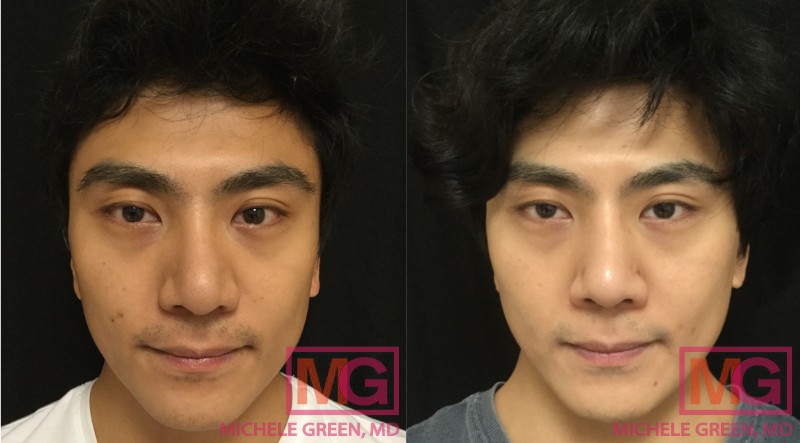
Mesoestetic chemical peel for hyperpigmentation and sun damage
After the summer, many of us realize that the damaging effects of the sun have caused new sun spots, solar lentigos, melasma, and ephelides. Sometimes, our skin becomes discolored and sun-damaged despite our best efforts and sun protection. The Mesopeel system of chemical peels addresses these concerns and reverses sun damage. Mesopeels are best when combined with topical depigmentation creams and chemical exfoliants. Mesospeels can address acne, skin blemishes, dyschromia, superficial lines, and deep wrinkles. It is always important to wear proper sun protection and limit sun exposure to the treatment area post-peel, as the skin cells responsible for producing melanin (pigment) are triggered by UV exposure. Dr. Green recommends layering two types of sunscreens, a chemical and physical sunblock, for the best sun protection.
Which areas can you treat with a Mesopeel?
- Face
- Arms
- Chest
- Buttock
- Back
- Axillae
- Groin
- Inner thighs
- Periocular (around the under eyes)
What are the different types of Mesoesetic mesopeels?
- Glycol acid 70% peel
- Trichloroacetic acid 35%
- Modified Jessner
- Melanostop Trans3X
What is a Melanostop peel?
A Melanostop peel is a special formulation to treat areas of hyperpigmentation on the body and facial melasma. This unique chemical peel can lighten dark spots on all skin types and skin tones without irritation. With a series of Melanostop peels, dark areas of the face and body reduce and fade in size. These peels can also be used for the delicate skin around the eyes, axillae, inner thighs, groin, chest, back neck, buttocks, and face. Many patients suffer from pigmentation in these delicate areas or post-inflammatory hyperpigmentation from acne breakouts or irritation. The Melanostop Trans 3X peel is uniquely compounded to remove this pigmentation without downtime or side effects.
What are the active ingredients in the Melanostop trans 3X?
The Melanostop Mesopeel has four important active ingredients. It is composed of the following:
- 20% Azelaic
- 10% Resorcinol
- 6% Phytic
- 3% Tranexamic Acid
How long do you leave the Mesopeel on?
- Face: 10 minutes
- Neck: 2 minutes
- Body including axillae and groin area: 5-7 minutes
Other types of Mesoestetic Mesopeels
There are different types of Mesopeels with different chemical bases, including Mesopeel TCA, Mesopeel Salicylic acid, Meosopeel Glycolic acid, Mesopeel Azelan, Mesopeel Lactic acid, and Mesopeel Mandelic acid. The following Mesopeels are designed to treat the various skin concerns:
Mesopeel Salicylic acid: is a beta-hydroxy acid (BHA) with a strong keratolytic, comedolytic, anti-inflammatory, and anti-microbial effect. Mesopeel Salicylic acid treats acne, dilated open pores, both comedogenic and inflammatory acne, seborrheic dermatitis, and sebaceous glands, reduces pore size and evens skin tone.
Mesopeel Glycolic acid: is one of the most popularly used alpha-hydroxy acids (AHA), which is an effective anti-aging treatment, improves skin tone, treats fine lines and wrinkles, photo-aging, and improves the appearance of stretch marks and superficial to deep acne scars
Mesopeel Azelan acid: treats rosacea and acne
Mesopeel Lactic acid: is best used for hydration, treating dull skin, and increasing the skin’s brightness.
Mesopeel Mandelic acid: reduces pore size and sebaceous gland secretion, improves skin tone, reduces dyschromia, and evens pigmentation.
Mesopeel TCA: TCA stimulates the activity of fibroblasts responsible for synthesizing the different macromolecules of the extracellular matrix (structural glycosaminoglycans and proteoglycans).
Mesopeel Melanoplus: A blend of depigmenting acids that are used to target lentigines, dark spots, and other areas of focal hyperpigmentation
What does the Mesopeel Melanostop treat?
The mesopeel Melanostop is indicated for treating epidermal pigmented lesions, solar lentigos, ephelides, melasma, hyperpigmentation, and similar dyschromia. One of the key ingredients in Mesopeel Melanostop Trans 3X is Phytic acid. Phytic acid is a powerful copper-chelating agent. Copper is an essential cofactor for activating tyrosinase, and so it has important depigmenting and antioxidant effects, will brighten skin discoloration, and even out skin tone. The keratolytic activity of the peel increases the exfoliation of the superficial layers of the stratum corneum by altering corneocyte adhesion. The Mesopeels stimulate cell regeneration, boost glycosaminoglycan synthesis and help improve skin quality, and increase collagen and elastin production. The Melanostop peel is uniquely formulated for the delicate axillae, groin, upper thighs, breast, chest, buttocks, or under-eye area.
Mesopeel Periocular: to treat under eye dark circles and wrinkles around the eyes
A new chemical peel for treating the periorbital area is the Mesoepeel Periocular peel. It is a unique chemical peel composed of azelaic acid, salicylic acid, lactic acid, resorcinol, citric acid, and phytic acid. This chemical peel is uniquely formulated to treat the periorbital area. It specifically aids in reducing the wrinkles in the eyelids (upper and lower), crow’s feet, hyperpigmentation, skin laxity, under-eye circles, and loss of brightness. If you have tired-looking eyes and want a non-surgical way to improve their appearance, Mesopeel Periocular is an amazing anti-aging chemical peel to accomplish your eye rejuvenation.

Can Mesopeels be combined with other cosmetic treatments?
Yes! Dr. Green regularly combines gentle yet effective Mesopeel treatments with other non-invasive cosmetic anti-aging treatments. Botox injections, V-beam laser treatments for redness, dermal fillers, and skin tightening lasers such as Thermage are among just a few of the types of complementary treatments that patients elect to undergo in addition to their Mesopeel treatment for hyperpigmentation. Many patients choose to schedule multiple cosmetic treatments simultaneously to take advantage of the skin rejuvenating effects of different types of procedures. When you consult with Dr. Green, you will have the opportunity to discuss in depth your specific skincare concerns and the cosmetic effects you’d like to achieve with your treatments. She will then make the appropriate recommendations for you to deliver optimal cosmetic results on the best timeline.
Do mesopeels work?
Yes! Mesopeels are a safe and effective treatment for reducing hyperpigmentation and creating a more even skin tone in many body and face areas. Mesopeels work on the face, undereye area, inner thighs, axilla, and several other body areas. It is important to remember that several mesopeel treatment sessions are required to achieve ideal results and gradually reduce hyperpigmentation. Most patients require an average of four to six mesopeels to obtain optimal rejuvenation results. Patients with more severe hyperpigmentation will require additional treatment sessions. To determine whether mesopeel will work for your specific skin concerns, schedule a consultation with an expert, such as board-certified dermatologist Dr. Michele Green in NYC. Dr. Green has over two and a half decades of experience treating hyperpigmentation in patients of all skin tones and will work with you to determine which chemical peel treatment will provide you with ideal results.
Which peel is best for hyperpigmentation?
The best chemical peel for reducing hyperpigmentation depends on the type of hyperpigmentation, the patient’s skin tone and skin type, and the area of the body or face being targeted. The best way to determine which type of chemical peel treatment suits your skin concerns and aesthetic goals is by consulting an experienced board-certified dermatologist, such as Dr. Michele Green, in New York City. Dr. Green is a world-renowned expert in cosmetic dermatology with over two and a half decades of experience providing some of the world’s most discerning individuals with the best non-invasive cosmetic treatment options available, including chemical peels for rejuvenation. Dr. Green offers a variety of chemical peel treatments, including Cosmelan, Mesopeel, and trichloroacetic acid chemical peels. When you have your consultation with Dr. Green at her private dermatology office in Manhattan’s Upper East Side neighborhood, she will work with you to create a customized treatment plan that incorporates the in-office cosmetic procedures and specially-formulated, at-home skincare products that will address your specific needs and personal cosmetic goals.
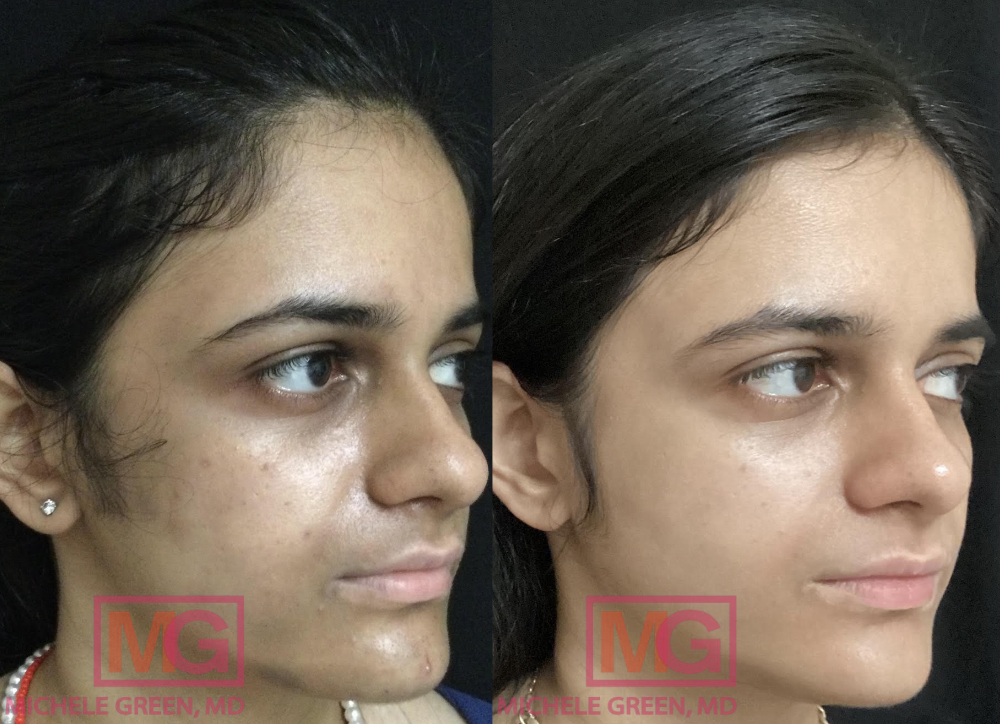
Is a mesopeel permanent?
A mesopeel chemical peel treatment that provides long-lasting or permanent skin rejuvenation results. To achieve and maintain ideal results, it is critical to use proper sun protection and limit sun exposure during the course of your treatment and post-peel. Melanocytes, the skin cells that produce melanin (pigment), are triggered by UV exposure. Without proper sun protection, these skin cells are activated to produce more melanin, causing hyperpigmentation to worsen or return post-peel. When you have your mesopeel treatment with board-certified dermatologist Dr. Michele Green, you will receive all the pertinent aftercare information required to achieve and maintain optimal cosmetic results.
How often should you do mesopeels?
Dr. Green recommends a series of 4-6 mesopeel treatments, each spaced several weeks apart, to achieve the best rejuvenation results. Gradual improvement occurs with each mesopeel treatment. To enhance the process, Dr. Green may recommend using specially-formulated skincare products at home, including those with active ingredients like vitamin C, glycolic acid, lactic acid, hydroquinone, retinol, or azelaic acid. Your treatment plan will be customized with Dr. Green during your initial consultation for hyperpigmentation, and treatment progress will be monitored and adjusted as needed during each follow-up visit.
How do I get started with Mesopeels / Chemical Peels today?
A chemical peel is a great non-invasive resurfacing treatment for targeting various skin concerns such as wrinkles and fine lines, superficial acne scars, hyperpigmentation, and more. There are many different kinds of chemical peels and several types that Dr. Green utilizes in her private dermatology office, located in the Upper East Side neighborhood of Manhattan. To get started with your facial rejuvenation treatments and understand which chemical peel is best suited to you, address your specific skin concerns, and achieve your personal cosmetic goals, schedule a consultation with Dr. Michele Green. Dr. Green is a board-certified cosmetic dermatologist with over twenty-five years of experience and internationally appreciated expertise in non-invasive cosmetic treatments, including chemical peels.
If you are bothered by hyperpigmentation on the face or body and are looking for a solution that is painless, quick, and doesn’t require any downtime whatsoever, the Mesopeel may be just the treatment for you. The Mesopeel was designed for depigmenting body areas where the skin is too sensitive to treat with traditional chemical peels, including the under eyes, neck, axillae, inner thighs, and groin. No matter what your skin concern, Dr. Green is here to help.
Dr. Michele Green is an internationally renowned board-certified cosmetic dermatologist with over two and a half decades of experience providing some of the world’s most discerning individuals with the best treatment options available. In addition to providing the best in non-invasive depigmenting treatments, Dr. Green performs what is known as the “best Botox in Manhattan,” cosmetic dermal fillers, laser skin resurfacing treatments, Thermage laser for skin tightening, microneedling, and PRP injections. She is consistently identified as one of New York’s best dermatologists by Castle Connolly, New York Magazine, Super Doctors, and the New York Times for her dedication to her patients and expertise. To schedule a consultation with Dr. Green and learn more about Mesopeels and other non-invasive treatment options for pan-facial rejuvenation, contact us online today or call 212-535-3088 and get started with your customized treatment approach.
 212-535-3088
212-535-3088 